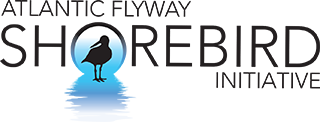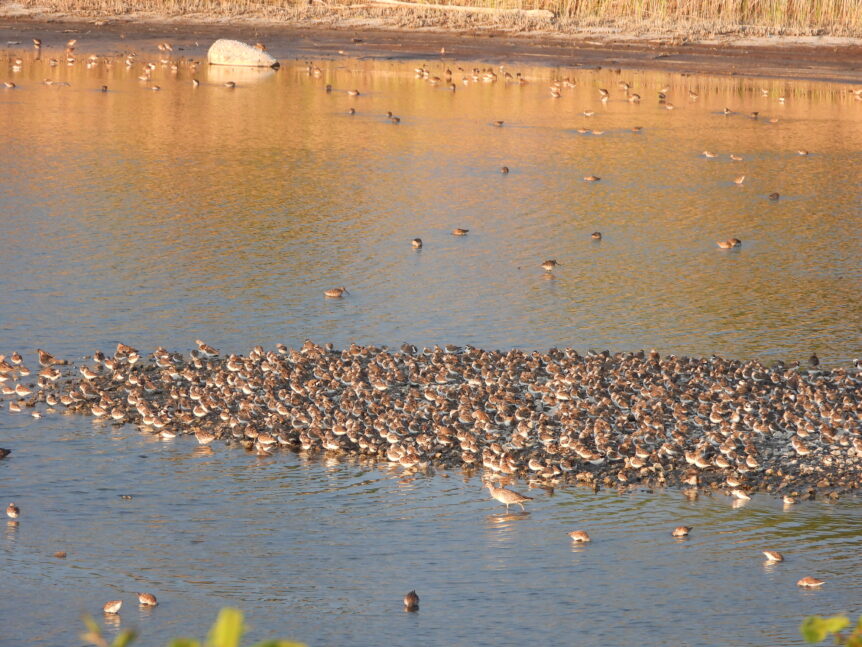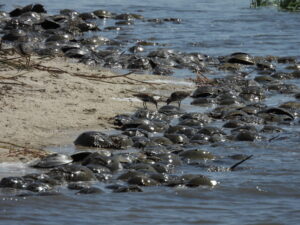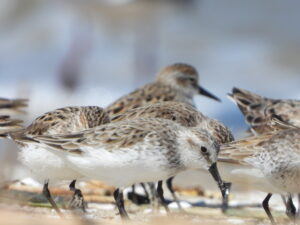Story By: Salvadora Morales, David Mizrahi & Jason Mobley
Synchrony: Shorebirds and Horseshoe Crabs
In late February and March in Brazil, Colombia, Nicaragua, and across all wintering sites, Semipalmated Sandpipers (Calidris pusilla) and other long-distance migratory shorebirds prepare for their spring migration. They will undertake flights of several thousand kilometers to reach end routes staging sites and then their Arctic breeding areas. Before leaving their non-breeding sites they feed frantically to build muscle mass and accumulate fat, and then wait for favorable winds. At the same time, in almost perfect synchrony, horseshoe crabs (Limulus polyphemus) wait for the coastal waters of the Atlantic Ocean to warm up before coming ashore to lay their eggs on beaches. Shorebirds typically arrive along the US Atlantic coast when horseshoe crabs begin to spawn on the beaches and the crab eggs will be the main source of energy for shorebirds as they travel to their breeding sites. When they arrive at stopover sites, they arrive incredibly thin. A typical Semipalmated Sandpiper arrives in Delaware Bay weighing approximately 20 grams and will double its weight during the two-week stopover to continue its journey. The energy they accumulate in the non-breeding grounds is barely enough to get them to the Delaware Bay. If water temperatures are too cold, the crabs will not come to the beaches to spawn. If they warm too early, the synchrony could be lost and disastrous for the birds. Stopping and finding food can make the difference between life and death.
Connecting the Dots Initiative
Connecting the Dots International Shorebird Conservation Initiative, connects shorebirds, shorebird reserves, people, and topics. The program started in 2005 by Dr. David Mizrahi, Vice President for Research and Monitoring at New Jersey Audubon. To address the full life cycle of birds and understand the challenges, the initiative not only works in Delaware Bay, but also since 2008 in Brazil, Suriname and French Guiana, and supports capacity building of the Gulf of Fonseca team in Central America. The focal species of the initiative is the Semipalmated Sandpiper. Between May and early June in Delaware Bay, birds are captured, banded, and marked with green flags and unique codes. Monitoring provides insight into population trends over time and the physical condition of the birds. One of the most important components of the Connecting the Dots Initiative is to provide opportunities capacity building of the researchers in other parts of the hemisphere who participate in the banding campaigns and who come from the tropics. To date, thirty-five volunteers from eleven countries have participated. From 2005 to 2011 the initiative partnered with the National Park Service’s “Parks in Flight” program that brought people from Central and South America. Since 2012 this effort has been supported by various grants to NJ Audubon, which has helped sustain the program over the past 10 years.
How are the sites connected?
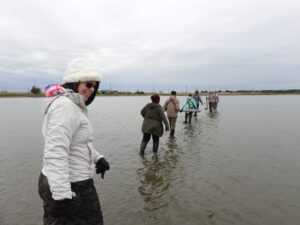
Installing mist nets for shorebird monitoring in Heislerville Wildlife Management Area at Delaware Bay.
Jason Mobley, Gabriela Ramires and Onofre Monteiro were part of the banding team this year. They coordinate the Migratory Birds Program of Brazilian NGO Aquasis – Associação de Pesquisa e Preservação de Ecossistemas Aquáticos. They also conduct shorebird banding campaigns during the non-breeding season at Banco dos Cajuais, the third such WHSRN site in Brazil nominated by Aquasis in 2017. With the support of Dr. Mizrahi, the Canadian Wildlife Service and CEMAVE (the federal entity that oversees bird banding in Brazil) in the early years of building the program the Aquasis team developed their technical capacity by working together at both Banco dos Cajuais and Delaware Bay. In addition to banding and telemetry-based studies, NJ Audubon and Aquasis have been working to identify best practices for shrimp farming in northeastern Brazil. These efforts are the foundation of Aquasis’s shorebird conservation strategy and are informing conservation planning and management of existing and proposed protected areas throughout the semi-arid northeast coast of South America.
This year’s Delaware Bay banding team also included Yoleydi Mejia of Quetzalli, Nicaragua’s Research Program and Salvadora Morales, Manomet’s Shrimp Farming and Conservation Specialist. Both work at the Estero Real Delta Shorebird Reserve, also part of WHSRN, and like the team from Brazil, they are working with shrimp farmers to develop a program for Conservation Shrimp Farming and Shorebird Friendly Shrimp. Finally, Marlyn Zuluaga, Colombian and PhD student at the University of Florida was part of this year’s Delaware Bay team. The coordination of David Mizrahi and Lena Usyk made the 2022 banding campaign one of the most beautiful human experiences for all of us who participated.
What was learned during the banding campaign?
Delaware Bay is a site that provides many lessons for those coming from the tropics, as well as a model for shorebird research, monitoring, and management. The first lesson for some of the participants was the importance of Delaware Bay as a major staging site shorebirds during spring migration, the way in which the birds congregate by species, unlike what is observed in the Delta del Estero Real, where the species all rest together in the same spaces. In Delaware Bay, different species use different areas to forage but eventually come together to roost. Participants learned capture techniques (whoosh net, mist net), extraction of birds, safe handling of captured birds, how to attach bands and coded leg flags, how to collect blood samples, and how to attach radio transmitter (e.g., nanotags, Lifetags). Once the birds are marked with coded leg flags, birdwatchers and other researchers can report birds re-sighted elsewhere in the hemisphere (www.bandedbirds.org). For all the 2022 program participants it was also a tremendous learning experience. Yoleydi Mejía expressed “that participating in this initiative was a privilege, the experience helps to learn everything that can be studied about shorebirds, learn about technology and understand the great gap that we still have in our countries”.
How was the banding campaign this season?
David Mizrahi explained “the 2022 field season was somewhat difficult compared to other years but overall, better than the previous two years, which were affected by COVID-19. Unfortunately, there seemed to be fewer birds compared to 2019, our last good year before COVID. They were spread out over many more sites than in the past, which made it more challenging to catch birds. As a result, we banded only 1279 C. pusilla, 30% fewer than our pre-Covid average of ~1800. Horseshoe crab spawning was good this year and there seemed to be plenty of eggs available for the shorebirds to eat. One of the problems shorebirds stopping in Delaware Bay are now facing is Peregrine Falcons that now breed regularly around Delaware Bay. Pressure from these predators has resulted in shorebirds abandoning some of their favorite foraging and roosting sites that might be too risky. This problem, combined with the high variability in horseshoe crab egg availability year-to-year could result in the decline of Delaware Bay as a premier staging area for migrating shorebirds. Survival and reproductive success of many shorebirds is dependent on a safe and healthy Delaware Bay, so we are working to safeguard the integrity of this critical migration stopover.”

Flagged Sandpiper with light green and HY* code feeding at Money Island, Delaware Bay. Salvadora Morales
There are many stories we could tell from 32 days of banding and field observations. For example, we captured the individual marked with a light green flag and the code “1Y8,” that was banded in 2013. 1Y8 is at least 10 years old and has traveled 100,000 miles between its home in the tropics and it breeding grounds in the Canadian Arctic. Also, on May 23rd we had a Latin holiday, a wave of Red Knots arrived from Chile, Argentina and Peru with yellow, orange flags, light green, dark green, but we will tell you that story in full in another space and time.
Do you want to be part of the 2023 banding campaign?
Contact David Mizrahi, david.mizrahi@njaudubon.org or Jason Mobley, jason@aquasis.org
To report shorebirds with flags and code contact Lena Usyk at bandedbirds1@gmail.com
